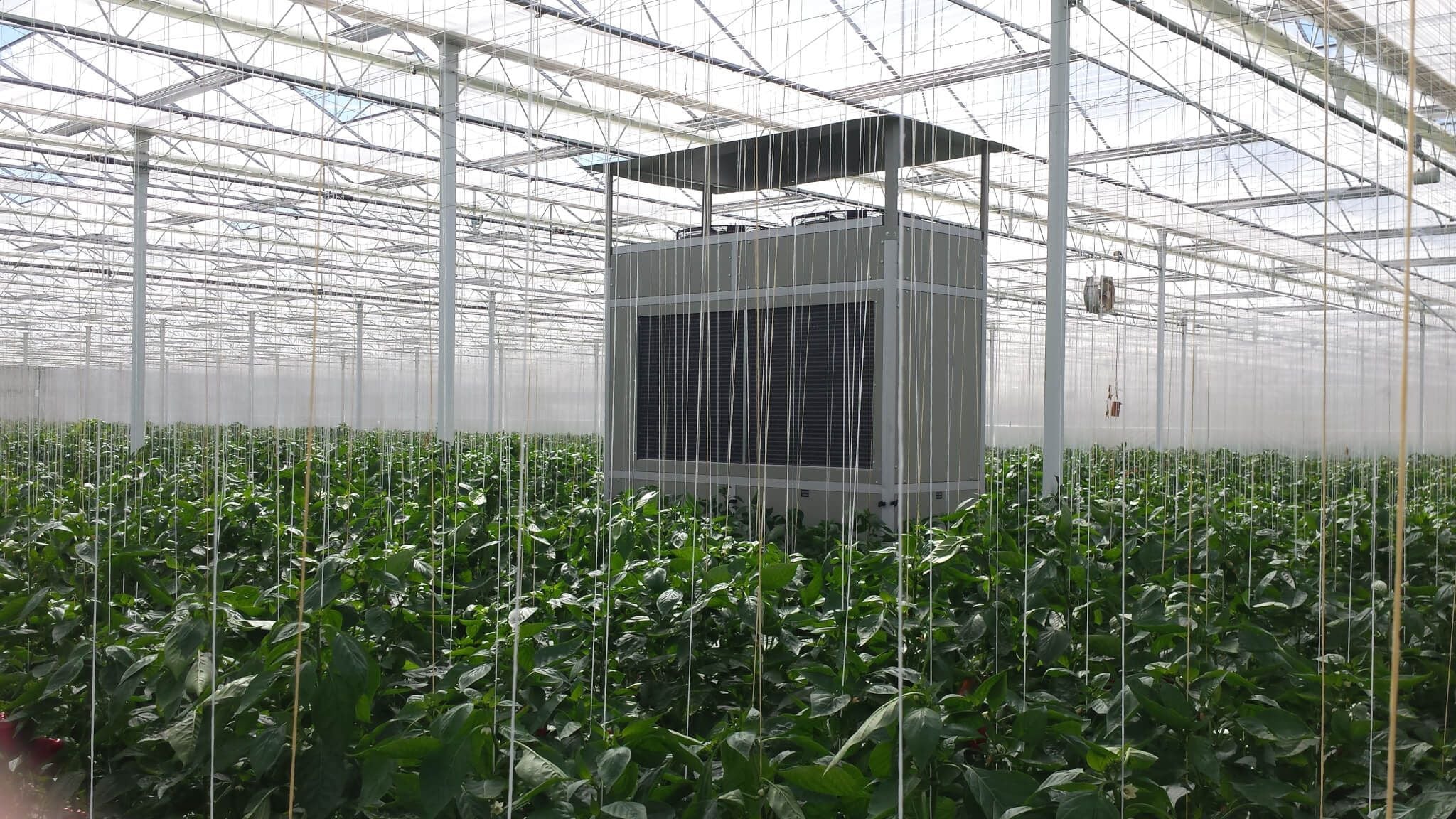Mastering Greenhouse Dehumidification & Energy Efficiency in Canada
)
Greenhouse dehumidification and energy efficiency are essential for Canadian greenhouse operations, where climate variability, high humidity, and fluctuating energy costs affect plant health and operational expenses. Proper humidity control not only protects crops but also improves energy efficiency, and Ontario-based research has confirmed the return on investment (ROI) for implementing strategic measures.
Why Humidity Control is Critical in Canada
Canada’s diverse climate—with its frigid, dry winters and humid, often unpredictable summers—poses a unique challenge for greenhouse operators. In the winter months, while outdoor air may be dry, the heating required inside greenhouses creates an environment with high levels of humidity. Warm air holds more moisture, and in tightly controlled greenhouse environments, this often leads to excess humidity that can harm crops. In the summer and shoulder seasons, outdoor humidity levels rise, compounding the challenge of managing internal moisture without dramatically increasing energy consumption.
Humidity management is essential for preventing plant diseases, ensuring optimal photosynthesis, and maintaining the structural integrity of greenhouse facilities. Excess humidity often results in condensation on glazing, framing, and other structural elements. This not only risks dripping onto crops but also contributes to corrosion and mold development on surfaces, potentially compromising food safety standards. Moreover, when humidity levels are not properly controlled, growers may overcompensate with heating and ventilation, leading to excessive energy usage and inflated operational costs.
The Humidity Challenge
Humidity is a byproduct of plant transpiration and evaporation within the greenhouse. When plants release water vapor into the air, the relative humidity (RH) can rise quickly, particularly in densely planted or poorly ventilated environments. The three most pressing issues caused by high humidity are plant disease, condensation, and energy waste.
Plant Disease: Pathogens such as Botrytis cinerea (gray mold), downy mildew, and powdery mildew thrive in humid conditions. These fungal diseases can spread rapidly when RH exceeds 85%, causing devastating crop losses. Preventing their spread requires active dehumidification strategies.
Condensation: When warm, moist air encounters cold surfaces, it condenses into water droplets. In a greenhouse, this can drip onto plants, create ideal environments for mold, and even cause physical damage to crops.
Energy Waste: High humidity requires increased ventilation to prevent disease, but in Canadian climates, this often means venting out warm air and pulling in cold, dry air. This creates a heating burden, raising energy consumption dramatically.
In Ontario, data from greenhousecanada.com shows that without dehumidification, average greenhouse RH during winter can remain above 80%, while optimal ranges for most crops are between 50-70%. This mismatch leads to a direct loss in yield potential and profitability.
Mechanical Dehumidifiers
Mechanical dehumidifiers are one of the most direct tools available for controlling greenhouse humidity. There are three main types:
Refrigeration-based dehumidifiers: These systems cool air below its dew point, condensing moisture out of the air. The dry air is then reheated before being returned to the greenhouse. While effective in moderate climates, they can become energy-intensive in large-scale operations or in environments where continuous dehumidification is required.
Solid desiccant systems: Using materials like silica gel or zeolites, these systems physically adsorb moisture from the air. They perform especially well in low-temperature environments but require additional energy to regenerate the desiccant material.
Liquid desiccant systems: These involve the use of a hygroscopic solution that absorbs water vapor from the air. Liquid desiccant systems can be integrated with heat recovery technologies, making them particularly appealing for energy-conscious greenhouse growers.
Energy efficiency in mechanical dehumidification depends on accurately calculating the latent heat load—the amount of energy required to remove a given quantity of moisture. For instance, removing one liter of water vapor releases approximately 2,500 kJ of latent heat. If not accounted for, this can result in unnecessary over-dehumidification, creating a drier environment than plants require and increasing heating loads.
Heat-Recovery Ventilation
Heat-recovery ventilation (HRV) systems offer a sustainable way to manage both humidity and heating costs. These systems extract warm, humid air from the greenhouse and replace it with fresh outdoor air, all while transferring the heat from the outgoing air to the incoming air. In Canada’s cold climate, this function is invaluable.
Data from rogersgreenhouse.com and psecommunity.org indicates that HRV systems can reduce heating costs by up to 30% when designed for greenhouse environments. Advanced HRVs also come equipped with integrated sensors that monitor humidity, CO2 levels, and temperature, ensuring that ventilation only occurs when necessary. By doing so, they reduce the energy wasted in over-ventilation and create a more stable growing environment.
A practical example: a 20,000-square-foot greenhouse in Southern Ontario that adopted HRV technology reported not only lower heating costs but also a 15% reduction in disease outbreaks due to more stable humidity levels.
Lighting Interaction
Lighting systems significantly affect greenhouse humidity levels because they directly influence plant transpiration rates. High-pressure sodium (HPS) lamps generate high levels of radiant heat, warming the plant canopy and increasing evaporation rates. This results in higher humidity levels that then need to be managed through dehumidification systems.
LED lighting, on the other hand, emits less heat, lowering the transpiration demand on plants. Research from psecommunity.org shows that transitioning from HPS to LED systems can reduce humidity levels by 10-15%, as less water evaporates into the greenhouse air. Additionally, LEDs reduce energy consumption by up to 40%, making them a crucial component in an integrated greenhouse energy management strategy.
Integrated System Design
Managing greenhouse dehumidification and energy efficiency cannot rely on isolated systems—it requires a holistic, integrated approach. Key elements include:
Coordinated ventilation and dehumidification: Ventilation systems must work in harmony with dehumidifiers. For example, running both at cross purposes can increase energy costs without reducing humidity effectively.
HVAC synchronization: Heating and cooling systems must be tuned to complement dehumidification rather than create conflicting conditions.
Data-driven control strategies: Real-time sensors provide accurate information on humidity, temperature, and plant transpiration rates, allowing for precise, automated adjustments.
Growers implementing integrated climate management systems often report improved consistency, with humidity kept within a 3-5% variance of target levels. This stability leads to healthier plants, reduced disease risk, and more predictable energy costs.
Energy Efficiency & Rebates
As Canadian provinces work toward carbon reduction targets, numerous programs are available to help greenhouse operators improve energy efficiency. In Ontario, incentives include rebates for high-efficiency dehumidifiers, HRV installations, and LED conversions.
Operational savings for a well-optimized greenhouse can include:
15-25% reduction in heating demand
Lower peak electricity usage
Reduced greenhouse gas emissions by several tonnes annually
These savings are often complemented by government-funded programs offering financial incentives, making energy-efficient upgrades more accessible for small and large growers alike.
ROI & Lifecycle Cost
Investments in greenhouse dehumidification and energy efficiency systems may appear significant upfront, but their long-term financial impact is substantial. Consider a five-year projection for a 10,000-square-foot greenhouse in Ontario:
Initial investment: $150,000 (including mechanical dehumidifiers, HRV integration, and LED lighting retrofit)
Annual energy savings: $30,000
Reduced crop loss: $20,000/year
Rebates and incentives: $25,000 upfront from provincial programs
By year three, the investment typically breaks even. By year five, cumulative savings can exceed $125,000, not including indirect benefits such as improved crop quality, reduced chemical usage, and a more stable production schedule.
Next Steps
Mastering greenhouse dehumidification and energy efficiency in Canada is no longer optional; it is critical to competitive, sustainable operations. By adopting advanced dehumidification technologies, optimizing lighting, integrating heat-recovery systems, and leveraging provincial rebates, growers can protect their crops, lower costs, and enhance profitability.
For greenhouse operators ready to make the next step, a technical consultation is the first move. Expert analysis of your greenhouse’s climate, crop type, and energy consumption can identify the ideal blend of mechanical, environmental, and technological solutions to create a healthier, more profitable future.
| Tags:GreenhouseLatest NewsGreenhouse Climate Controls |

